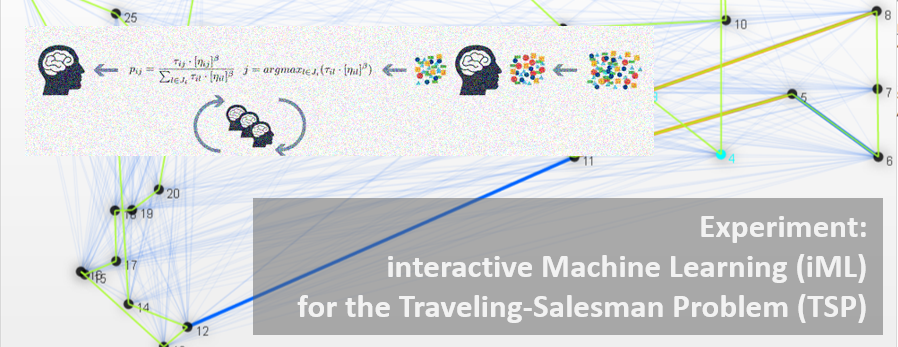Welcome! Thank you for participating in this very short and anonymous on-line experiment; please follow the instructions below …
Background: Interactive Machine Learning (iML) can be defined as “algorithms that can interact with agents and can optimize their learning behavior through these interactions, where the agents can also be human [1], [2].” This “human-in-the-loop” can be beneficial in solving computationally hard problems [3], where human expertise can help to reduce an exponential search space through heuristic selection of samples. Therefore, what would otherwise be an NP-hard problem, reduces greatly in complexity through the input and the assistance of an human agent involved into the learning phase.
Experiment: In this on-line experiment we evaluate the effectiveness of the iML-”human-in-the-loop” approach, particularly in opening the ”black box”, thereby enabling a human to directly manipulating and interacting with an algorithm. For this purpose, we selected the Ant Colony Optimization (ACO) framework, and apply it on the Traveling Salesman Problem (TSP) [4], [5] which is an NP-hard problem and is of high importance in solving many practical problems in health informatics, e.g. in the study of proteins etc.; however, you can see the nodes (vertices) as cities and may ask the following question: “Given a list of cities and the distances between each pair of cities, what is the shortest possible route that visits each city exactly once?”
Instruction – please follow these for all three data sets:
Your goal is to find the shortest connection between all cities, and you can adjust with “Change Weight to …” the probability that a path is taken. Remark: It works with any Browser, but the use of Chrome brings faster results. It is recommended to watch the short instruction video below (2 minutes) first to fully understand what to do.
- 1) Press “Start” to initialize the algorithm
- 2a) Click “Pause/Resume” to pause the algorithm and to do your changes
- 2b) You may now select two cities by clicking on the respective nodes
- 2c) With “Change Weight to max/min” you can adjust the importance of the path between these two selected cities
- 3) Click on “Pause/Resume” to continue the algorithm
- 4) The steps above can be repeated as often as you wish
- 5) After 250 Iteration the algorithm automatically stops
- 6) Please continue with the next dataset
Thank you very much for your participation. If you wish to be informed about the outcome
of the experiment, please contact a.holzinger@human-centered.ai
References:
[1] Holzinger, A. 2016. Interactive Machine Learning for Health Informatics: When do we need the human-in-the-loop? Springer Brain Informatics (BRIN), 3, (2), 119-131, doi:10.1007/s40708-016-0042-6.
[2] Holzinger, A. 2016. Interactive Machine Learning (iML). Informatik Spektrum, 39, (1), 64-68, doi:10.1007/s00287-015-0941-6.
[3] Dossier: Interactive Machine Learning for Health Informatics
[4] Wikipedia: Travelling salesman problem (last visited: 01.08.2016, 18:00 CET)
[5] Google Scholar: Traveling salesman problem (last visited: 01.08.2016, 18:05 CET – 46,800 results)


